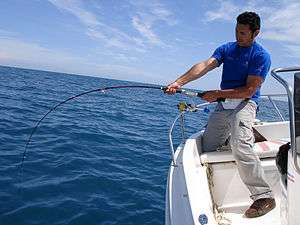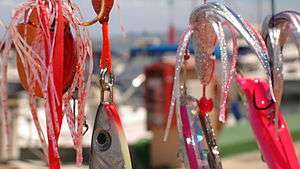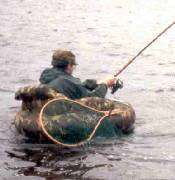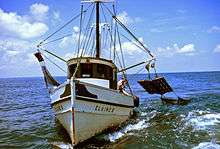Jigging
Jigging is the practice of fishing with a jig, a type of fishing lure. A jig consists of a lead sinker with a hook molded into it and usually covered by a soft body to attract fish. Jigs are intended to create a jerky, vertical motion, as opposed to spinnerbaits which move through the water horizontally. The jig is very versatile and can be used in both salt and fresh water. Many species are attracted to the lure which has made it popular among anglers for years.


For successful jigging, the jigger needs to use a rod which is good for feeling a strike, and needs to stay in contact with the lure and get it to where the fish are. Most fish caught by jigs are on or near the bottom.[1]
Head
The head of a jig can consist of many different shapes and colors along with different features. The most common is the round head, but others include fish head shaped, coned-shaped, or any number of varieties. The three most popular jighead shapes in bass fishing are the flipping jighead, the football jighead, and the grass jighead. These heads come in many different weights usually ranging from 1/80 of an ounce to nearly a pound for large saltwater bottomfish. They can also be found in a wide array of colors and patterns. The hooks also vary. These variances can be on the hook type, color, angle of the hook or the material of the hook. Some jig heads even offer a weed guard.
The body
There is a wide array of bodies for jigs. The most common is made out of rubber or silicone. These come in many shapes and can resemble a grub, frog, fish, paddle tail, lizard, or different insects. The colors of these can range from bright yellow to a transparent brown with silver and red flakes. Also, during summer months look at colors for the heat such as browns, or blue with black hair. Many others catch fish like smallmouth bass and largemouth bass. Bait such as minnows, leeches or night crawlers can also be used as jig bodies.
Other, more traditional types use dyed or natural whitetail deer tail hair on the outside. Called a bucktail jig, they are widely used in the northern and midwestern United States, where many are still hand tied by anglers.
Other types of materials are also used in constructing jig bodies, such as a Chenille wrap on the hook shaft, various feather hackle, hairs or other fur, marabou, Flashabou, and other materials. Construction is often similar to the process of Fly tying. Some jigs are constructed identically to their artificial fly counterparts, one example a "Wooly Bugger" fly but tied on a jig head.
Bodies can be either brightly colored or subdued. They are often designed to mimic local prey fish or large local insects.
See also
Notes
- Ken Schultz (1999) Ken Schultz's Fishing Encyclopedia Archived 2010-01-17 at the Wayback Machine Wiley. ISBN 978-0-02-862057-2
References
- Bjarnason, B A (1992). Handlining and squid jigging. FAO training series, No 23. ISBN 92-5-103100-2
- Gabriel, Otto; Lange, Klaus; von Brandt, Andres; Dahm, Erdmann and Wendt, Thomas (2005) Fish Catching Methods of the World. Page 178. Blackwell Publishing. ISBN 0-85238-280-4
- Gilbert, Daniel L; Adelman, William J and Arnold, John M (1990). Squid as experimental animals. Page 21. Springer. ISBN 0-306-43513-6
- Gruenwald, Tom (1999). Salt Water Fishing Tactics. Page 21–23. Creative Publishing. ISBN 0-86573-085-7
- Sternberg, Dick {2003}. The Ultimate Guide to Freshwater Fishing. Publishing Solutions, Page 82–84. ISBN 0-9725580-0-4
- Sternberg, Dick {2003}. The Ultimate Guide to Freshwater Fishing. Publishing Solutions, Page 258. ISBN 0-9725580-0-4
- Oberrecht, Kenn {1982}. Angler's Guide to Jigs and Jigging Tulsa, OK: Winchester Press. ISBN 0-87691-365-6.

